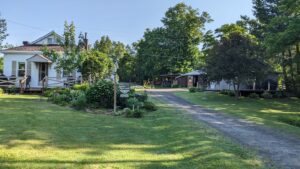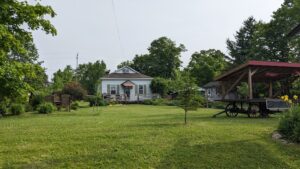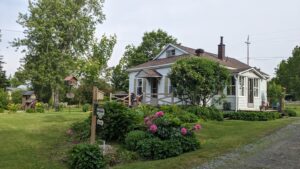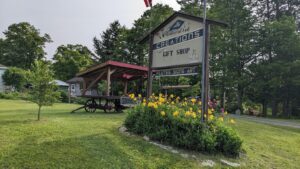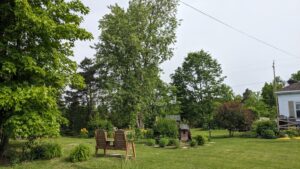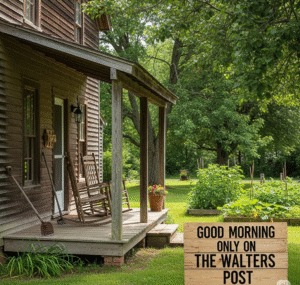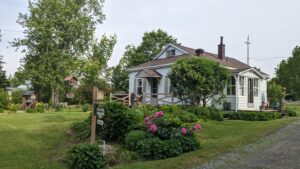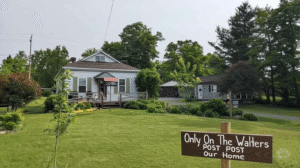Click on Image to Enlarge
Well, it’s a sunny start to the day here in Port Loring. It feels fresh out there this morning, sittin’ right around 58 F, which is about 15 C if you’re keeping track that way.
As the day moves forward, it’s looking to stay nice, a bit of sun, maybe a few clouds drifting by, but overall just a good, solid day. High should climb up to about 80 F, or 27 C. Good day to get things done outside or maybe just sit a spell in the shade if you’ve already done enough.
Come tonight, it won’t cool off too much. Expect it to dip down to around 62 F, or 17 C. Should be a quiet evening, maybe a few bugs depending on where you’re standing, but otherwise pretty mild.
Now tomorrow, that’s when things start to shift. It’s gonna cloud up some, and they’re saying we might get a couple showers, maybe even a thunderstorm in the mix. Air’s gonna feel heavier too, real warm and sticky. High’s supposed to hit around 86 F, or 30 C, with the low tomorrow night sittin’ close to 65 F, or 18 C.
Might be one of those days, where you get your outside work done early and then just keep an eye on the sky.
Highway 522: Well, traffic wise, it has picked up a lot. Campers, trailers, you name it, they’re all moving into our area. But it is the long weekend, the kids are out of school, and the city folks are wantin’ to leave that city life behind for a bit.
And I can’t say I blame them, neither. Up here, the air is fresh, the fish are waitin’ to eat some worms and keep the fishermen/women on their toes, and the blackflies are gone for another year.
They call it The Call of the Wild, and there ain’t no stronger force than nature, let me tell ya.
Bug Report:
All is quiet on the bug front… for now. But if this heat keeps creeping in like it might, you can bet those pesky deer flies and mosquitoes will be back out and about.
You see, they have been lying low, holding little bug meetings somewhere out in the bush, just waiting for the right time to come out and start irritating folks. And they always seem to seek out that nice warm city blood first. It’s a real treat to them.
Now, some folks think they are safe with bug spray, but I will tell you, most of that stuff today is not good for your health and truth told, it just works like a dinner bell letting the bugs know exactly where you are.
Instead of piling on bug spray, try not to put on any perfume or strongly scented soap. Wash your clothes in unscented soap, too. I use Dove or Ivory unscented, and it helps a lot.
So if you are heading outside, don’t forget your hat. It is your first line of defense. After that, you might be better off learning to swat fast and doing a little two-step than relying on a can of chemical hope.
On another note, yesterday despite the rain and the not-so-great weather in the morning, I ended up cleaning my woodworking shop. And in the afternoon, I wrote up another story for the newspapers I write for. All in all, it was a good day.
So what are you up to today, GW?
Well, with a day this nice, I’m planning to get outside and work in our vegetable gardens. I already spotted a few weeds trying to sneak in and get a foothold, and I’m not about to let them get the upper hand.
Speaking of the garden, I have to say, with all this wet weather we’ve had, things like tomatoes, peppers, broccoli, Brussels sprouts, squash, and a few others have really taken off. They’ve grown so much in just a few days that they’re starting to crowd each other like old neighbors at a family reunion.
That’s good in one way, but in other ways it’s not so great. Looks like I’ll have to do some thinning out soon, give everything a bit more breathing room before they start stepping on each other’s toes.
So with that bit of info out there for you to read, I am off to enjoy the breakfast my lovely wife has made for me. After that, I will head on out to our front porch, with a cup of green tea for a change, since it’s such a really nice day.
My wife and I sure do enjoy sitting outside just taking in our beautiful piece of property. It is one of those small things about living in the country that makes all the hard work worthwhile.
Until the next time: Keep Your Minds Open & Your Stories Alive. GW

